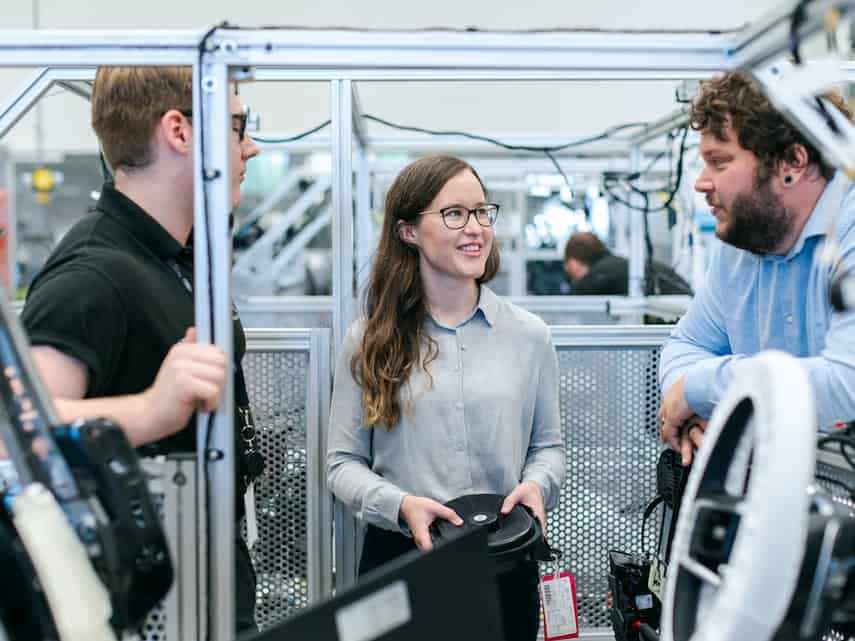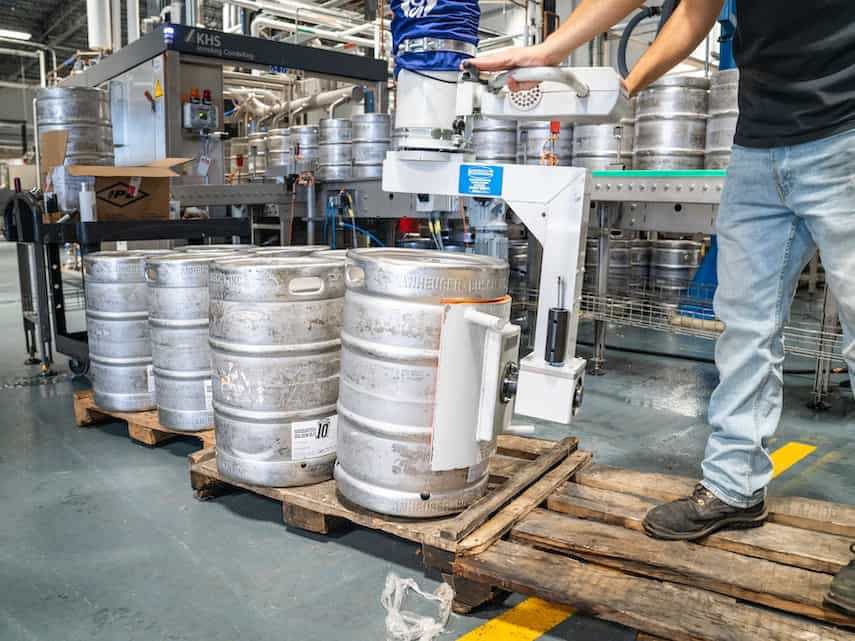
There are many ways to improve productivity in a manufacturing facility, but a lot of them are highly disruptive and cost a considerable amount of money.
What if there was a way to make tangible improvements to the business without breaking the bank or disturbing the status quo? Switching to a visual factory could be a quick win for any manufacturing business. Here’s how.
What is a visual factory?
A visual factory is a manufacturing facility in which processes, instructions, directions, and statuses are all visualised physically in some way across the shop floor. This ensures that everyone who needs to know where something is or how something works can learn it at a glance.
In a visual factory, it’s you can walk past a workstation, a whiteboard, or a piece of equipment and learn what you need to know without logging into a computer, flicking through pages, or asking lots of questions. This results in less downtime and higher productivity.
 LED wayfinding signs and Andon systems are popular tools for building out a visual manufacturing factory.
LED wayfinding signs and Andon systems are popular tools for building out a visual manufacturing factory.
How does a visual factory work?
The purpose of a visual factory is to simplify things and convey key information very quickly. It contributes to a lean manufacturing strategy, where minimising waste is a core principle.
Switching to a visual factory can reduce the time it takes to teach someone something new, to update management on statuses, or to identify where a particular task is along its process. It replaces text-based or conversation-based information with simplified images and other visual tools. This helps clarify processes and cut down time waste.
What information can be visualised?
In a visual factory, nearly everything can be given a visual key to help improve workflows.
Here are some examples of information that can be visualised:
- Standard operating processes, step-by-steps, and instructions
- Assembly line and production workflows
- Shop floor layouts, maps, pathways, key areas
- Metrics and KPI progress
- Plant information and statuses
- Warnings and need-to-knows
- Company information and updates
How each of these is visualised depends on the process or information itself, but let’s cover a few common methods.
How to visualise factory information
There are various systems – some basic, some complex – that can aid in creating a visual factory.
These include:
- Graphs and charts
- Kanban boards
- Andon systems
- Information boards and electrical display boards
- Floor markings and wayfinding signs
- Signs and labels
Most of these may be used in unison and help to contribute to greater factory visibility and efficiency.
 Visual factories can improve relationships among employees by minimising miscommunication and human errors in training.
Visual factories can improve relationships among employees by minimising miscommunication and human errors in training.
6 benefits of visual factories
The purpose of implementing visual cues in a factory or warehouse is to improve cash flow by cutting costs, speed up processes, and minimise the risk of human error.
Here are 6 important benefits of operating a visual factory:
- Simplify staff training: Switching from overwhelming text-based instruction manuals to simple step-by-step graphics can make it easier to train staff on new processes or equipment. This is especially beneficial to any manufacturer relying on seasonal, temporary or high-turnover staff.
- Improve efficiency: Ensuring each piece of equipment on your shop floor can be checked at-a-glance and wider processes can be followed step by step makes it easier for staff to work more efficiently
- Get better results: When staff can better follow a process and the status of their equipment, they can better guarantee optimal end results. There will be less guesswork involved and fewer errors.
- Improve safety: A more informed workforce is a workforce which is better able to keep itself safe. Clearer instructions, easier-to-follow processes and better knowledge overall can all lead to tangible safety improvements.
- Increase machine uptime: By ensuring staff are prompted and reminded about important maintenance and equipment handling steps, disruptive processes (like maintenance or changeover) can be done more quickly, leading to less downtime.
- Increase profit: Reducing waste reduces the amount of money you spend on that waste, and therefore improves the bottom line. Additionally, improved efficiencies and better end results can limit related problems like breakages, spoilage and defects.
Are there any disadvantages to a visual factory?
Some managers don’t like entirely replacing old text-based information with new visual at-a-glance information (as text-based info can contain significantly more detail).
But you don’t have to exchange one for the other. Utilising both is fine – visual-based information for the quick need-to-know stuff, and text-based for when you require detail.
However, there are a few challenges involved in adopting visual factory methodology. These typically arise from mistakes made during the implementation process.
Common visual factory mistakes to avoid include:
- Lack of buy-in from staff, leading to low adoption rates
- Not fully integrating new ideas into existing processes, meaning people don’t remember to use the new visual mediums
- The information being visualised is not optimal or helpful
- Management doesn’t lead from the front
With proper planning and appropriate change management, you can tackle all four of these concerns long before they’re ever a problem.
 Change management plays a critical role in the implementation of a visual factory system.
Change management plays a critical role in the implementation of a visual factory system.
Visual factories in lean manufacturing
Visual factories sit under the wider umbrella of ‘going lean’. Going lean refers to taking measures that will minimise the amount of wasted time, money, and labour that goes into production – with the aim of improving total value for the end customer.
Switching to a visual factory is all about improving efficiency and reducing time waste, making it a perfect pairing for lean manufacturing strategies.
The idea of simplifying through visuals is a fast and effective lean strategy. You can set it up relatively quickly compared to other serious changes, and it often doesn’t cost a lot of money; many of the materials required (such as whiteboards or floor markings) are themselves not particularly expensive.
Visual factories vs. Six Sigma and 5S
Six Sigma is a methodology designed to use data to improve business processes, eliminating defects and standardising the business.
The idea is that all areas of the business should be able to be measured, and if they can be measured they can be benchmarked, and if they can be benchmarked they can be tracked, optimised and made consistent.
Visual factories fit into the idea of lean Six Sigma, where Six Sigma practices are used to reduce waste and better control future work. These steps are both improved with visual aids.
5S is more specifically about eliminating waste and inefficiencies.
5S is a five-stage methodology focused on the idea of eliminating excess, organising what’s left, and keeping things consistent. As such, the idea of factory visualisation plays very neatly into the practice of 5S because visuals help simplify instructions, keep processes consistent and maintain order.
Visual manufacturing: Tips for getting started
Visual manufacturing is the way of working achieved when a visual factory system has been successfully implemented in a production facility. As with any process improvement tactic, visual manufacturing requires serious planning and consideration.
Before you get started, check out these helpful tips.
1. Don’t consider this a ‘set-and-forget’
Implementing a visual factory is not something you would generally just do all at once, and then forget about. Consider this an always-on process, where you visualise and optimise one thing at a time, slowly expanding and improving, before going back to the start and analysing it all again to hunt for further opportunities.
You will learn a lot about how to implement a visual factory by going through the process once.
Cycle those learnings back into the implementation process and regularly analyse your work. Talk to your people, listen to their feedback, and keep improving over time. This is how you’ll get the best results.
2. Take time to plan the implementation
A lack of planning can lead to wasted effort. You may wind up with useless information and spend money changing things around in a manner which is poorly optimised.
Before altering any existing processes, talk to your employees about what they do each day to gauge what works well and what doesn’t. Learn which tasks need to be done regularly for each piece of plant. Write it all down.
The goal here is to produce a set of process workflows for every single part of the business that you intend to optimise.
Additionally, take time to clarify your goals and objectives: What are you hoping to achieve? What does success look like?
Be as specific as possible and ensure that your goals align with the broader business strategy. This way, you’ll be working towards goals which can be measured and will benefit the organisation as a whole.
 You can reduce transportation and downtime by making it simpler to find key information through visual factory cues.
You can reduce transportation and downtime by making it simpler to find key information through visual factory cues.
3. Don’t skimp on change management
Change management is a vital element of any new implementation. It’s essential to get your staff involved and gain their buy-in before changing how they work.
Skipping this step could lead to disgruntled workers and a lack of (or severely hindered) adoption of any new processes. This increases the cost and decreases the success of implementation.
Here are a few tips for effective change management:
- Highlight key people in your organisation who are enthusiastic about the change. Make these employees your ‘change champions’ and keep them heavily involved. Train them first, and then utilise them to help train and support others.
- Always be transparent. You’re not doing this arbitrarily, so take time to explain your reasoning to staff: why this is all taking place, what will occur during the changeover (change often leads to temporary periods of disruption), and what it will look like when it’s over.
- Keep your teams involved. They know their jobs best. If you’re changing something that they do regularly, chances are their insight will help you optimise the new way of working. There may be things about their jobs that you don’t know you don’t know, and they can help you learn those in advance of making changes.
4. Lead from the top down
If you want to ensure that your new visual ways of working are utilised throughout the business, leadership needs to stay at the head of the charge.
Employees tend to follow what their leaders do. If your leadership team pushes for a change but doesn’t involve themselves with it, your workers will likely follow suit.
From C-suite executives down to individual team leaders, all leaders in the business should be champions of the visual manufacturing way of working and the first adopters.
Visual factory software
Visual factory software refers to the digital platform that helps to run a visual manufacturing plant.
In some cases, standard inventory management software can provide all the digitisation you need to run a visual factory. But for more complex or unique systems, specialised programs may be required.
Look for visual factory software that can integrate seamlessly with your other business software. This will enable real-time updating of stock movements and mitigate the risk of pickers being led to a SKU's former location instead of its current one.
Other considerations when purchasing visual factory software include subscription cost, onboarding costs, and ease-of-use.
Speak to a qualified consultant before implementing new visual manufacturing software. Make sure you understand all of the risks, timelines, and employee-affecting factors prior to beginning the project.
